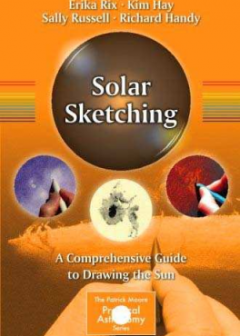Solar sketching: A comprehensive guide to drawing the Sun
| By Erika Rix, Kim Hay, Sally Russell & Richard Handy | Reviewed by Lee Cowley |
| Springer 2015 | xix + 424 pages |
| Price £24.99 (pbk) | ISBN:978 1 4939 2900 9 |

Drawing solar features at the telescope has a noble history extending back to Galileo. It remains a valuable activity even though rivalled by today’s CCDs. Sketching is a low investment and fun entry into solar observing yet also provides useful scientific records. Sketching sharpens observing skills; we see more. The transfer from eye to hand is via the mind and it gives perhaps a more direct, richer and memorable experience than photography. ‘Sketch’ does have connotations of something rough and unfinished; in this book, by four expert and acknowledged sketchers, it means quite definitely a careful and completed observational record.
The book’s body is a collection of tutorials on white light, H-alpha and, for those with young eyes, calcium K drawing. It shows how to draw the whole disk, active regions, plage, flares, prominences and filaments.
Materials are suggested followed by step-by-step guides laced with plentiful illustrations. The tutorials are lively and by individual named artists, some extra to the four authors. It is fascinating to compare their different sketching styles and approaches. They use ordinary graphite pencil, charcoals, dry or oil pastels, pens and specialised pencils of all types. These scribe on white, black and coloured papers. The text explains exactly how to use each medium.
There are no paints because there is no time for them. The Sun changes fast. Each sketch must take no more than a few minutes or even less if there are flares or eruptive prominences.
Are sketches made so quickly at all accurate? The book really needs to talk about accuracy. It needs some side-by-side comparisons of drawings and near-simultaneous images. Amateur equipment can generate superb H-alpha and white light images and many are available on the Internet. Frequent comparison with them is a key to confident work and continued technique improvement. Carefully drawn sketches can in fact be surprisingly accurate. The book should highlight that.
There is some very light-touch solar physics. We learn how to submit observations, sketch transits and eclipses, make animations and conduct solar outreach activities.
This is a fun book where the authors’ enthusiasm infects and inspires. There is plenty of material to get any would-be sketcher started and to provoke old hands into trying new things. I recommend it to both.
Les Cowley is a physicist currently specialising in atmospheric optics. He paints with acrylics on canvas. He authored the solar orientation software ‘TiltingSun’ and observes and draws the Sun in H-alpha light.
| The British Astronomical Association supports amateur astronomers around the UK and the rest of the world. Find out more about the BAA or join us. |
